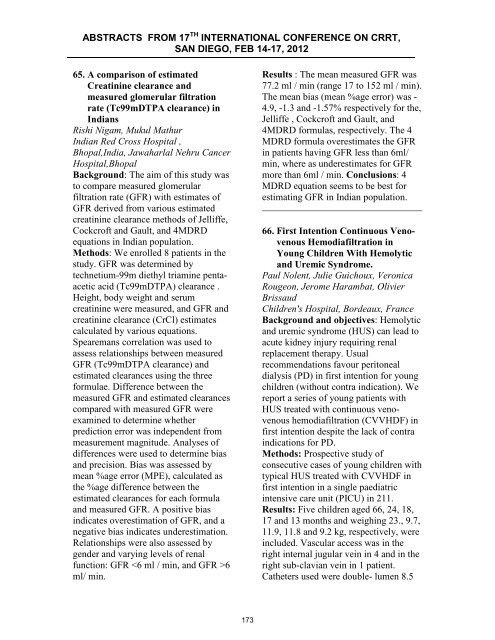ABSTRACTS from 16th International COnference on ... - CRRT Online
ABSTRACTS from 16th International COnference on ... - CRRT Online
ABSTRACTS from 16th International COnference on ... - CRRT Online
Create successful ePaper yourself
Turn your PDF publications into a flip-book with our unique Google optimized e-Paper software.
<str<strong>on</strong>g>ABSTRACTS</str<strong>on</strong>g> FROM 17 TH INTERNATIONAL CONFERENCE ON <strong>CRRT</strong>,<br />
SAN DIEGO, FEB 14-17, 2012<br />
65. A comparis<strong>on</strong> of estimated<br />
Creatinine clearance and<br />
measured glomerular filtrati<strong>on</strong><br />
rate (Tc99mDTPA clearance) in<br />
Indians<br />
Rishi Nigam, Mukul Mathur<br />
Indian Red Cross Hospital ,<br />
Bhopal,India, Jawaharlal Nehru Cancer<br />
Hospital,Bhopal<br />
Background: The aim of this study was<br />
to compare measured glomerular<br />
filtrati<strong>on</strong> rate (GFR) with estimates of<br />
GFR derived <str<strong>on</strong>g>from</str<strong>on</strong>g> various estimated<br />
creatinine clearance methods of Jelliffe,<br />
Cockcroft and Gault, and 4MDRD<br />
equati<strong>on</strong>s in Indian populati<strong>on</strong>.<br />
Methods: We enrolled 8 patients in the<br />
study. GFR was determined by<br />
technetium-99m diethyl triamine pentaacetic<br />
acid (Tc99mDTPA) clearance .<br />
Height, body weight and serum<br />
creatinine were measured, and GFR and<br />
creatinine clearance (CrCl) estimates<br />
calculated by various equati<strong>on</strong>s.<br />
Spearemans correlati<strong>on</strong> was used to<br />
assess relati<strong>on</strong>ships between measured<br />
GFR (Tc99mDTPA clearance) and<br />
estimated clearances using the three<br />
formulae. Difference between the<br />
measured GFR and estimated clearances<br />
compared with measured GFR were<br />
examined to determine whether<br />
predicti<strong>on</strong> error was independent <str<strong>on</strong>g>from</str<strong>on</strong>g><br />
measurement magnitude. Analyses of<br />
differences were used to determine bias<br />
and precisi<strong>on</strong>. Bias was assessed by<br />
mean %age error (MPE), calculated as<br />
the %age difference between the<br />
estimated clearances for each formula<br />
and measured GFR. A positive bias<br />
indicates overestimati<strong>on</strong> of GFR, and a<br />
negative bias indicates underestimati<strong>on</strong>.<br />
Relati<strong>on</strong>ships were also assessed by<br />
gender and varying levels of renal<br />
functi<strong>on</strong>: GFR 6<br />
ml/ min.<br />
Results : The mean measured GFR was<br />
77.2 ml / min (range 17 to 152 ml / min).<br />
The mean bias (mean %age error) was -<br />
4.9, -1.3 and -1.57% respectively for the,<br />
Jelliffe , Cockcroft and Gault, and<br />
4MDRD formulas, respectively. The 4<br />
MDRD formula overestimates the GFR<br />
in patients having GFR less than 6ml/<br />
min, where as underestimates for GFR<br />
more than 6ml / min. C<strong>on</strong>clusi<strong>on</strong>s: 4<br />
MDRD equati<strong>on</strong> seems to be best for<br />
estimating GFR in Indian populati<strong>on</strong>.<br />
66. First Intenti<strong>on</strong> C<strong>on</strong>tinuous Venovenous<br />
Hemodiafiltrati<strong>on</strong> in<br />
Young Children With Hemolytic<br />
and Uremic Syndrome.<br />
Paul Nolent, Julie Guichoux, Ver<strong>on</strong>ica<br />
Rouge<strong>on</strong>, Jerome Harambat, Olivier<br />
Brissaud<br />
Children's Hospital, Bordeaux, France<br />
Background and objectives: Hemolytic<br />
and uremic syndrome (HUS) can lead to<br />
acute kidney injury requiring renal<br />
replacement therapy. Usual<br />
recommendati<strong>on</strong>s favour perit<strong>on</strong>eal<br />
dialysis (PD) in first intenti<strong>on</strong> for young<br />
children (without c<strong>on</strong>tra indicati<strong>on</strong>). We<br />
report a series of young patients with<br />
HUS treated with c<strong>on</strong>tinuous venovenous<br />
hemodiafiltrati<strong>on</strong> (CVVHDF) in<br />
first intenti<strong>on</strong> despite the lack of c<strong>on</strong>tra<br />
indicati<strong>on</strong>s for PD.<br />
Methods: Prospective study of<br />
c<strong>on</strong>secutive cases of young children with<br />
typical HUS treated with CVVHDF in<br />
first intenti<strong>on</strong> in a single paediatric<br />
intensive care unit (PICU) in 211.<br />
Results: Five children aged 66, 24, 18,<br />
17 and 13 m<strong>on</strong>ths and weighing 23., 9.7,<br />
11.9, 11.8 and 9.2 kg, respectively, were<br />
included. Vascular access was in the<br />
right internal jugular vein in 4 and in the<br />
right sub-clavian vein in 1 patient.<br />
Catheters used were double- lumen 8.5<br />
173
















